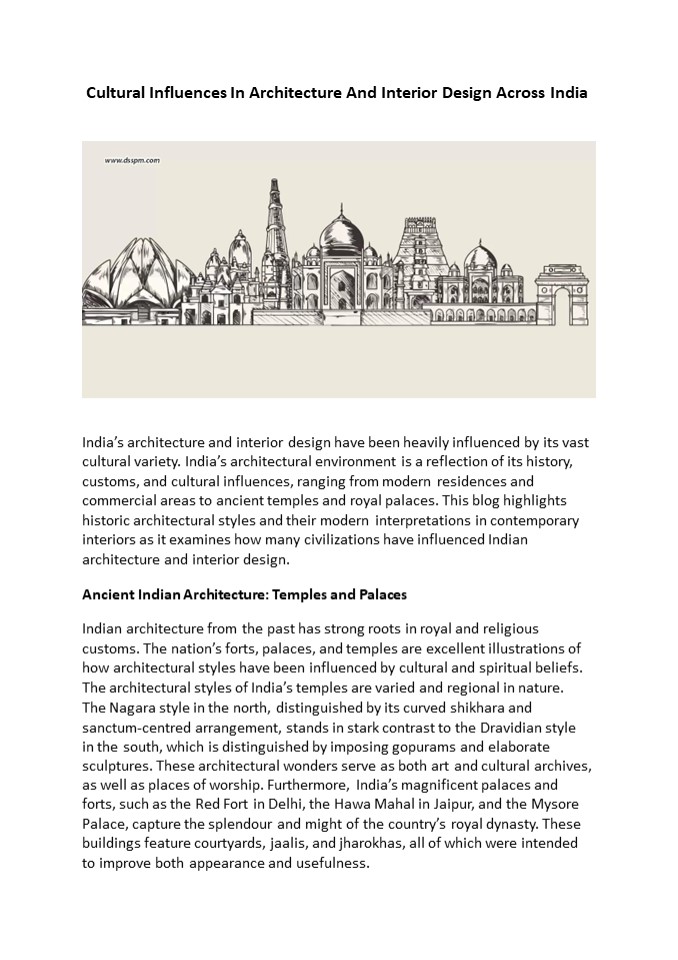Cultural Influences In Architecture And Interior Design Across India
Title:
Cultural Influences In Architecture And Interior Design Across India
Description:
Explore how India's rich cultural heritage influences architecture and interior design. Discover traditional styles and their modern interpretations, with insights from the best architects and interior designers in Ahmedabad. –
Number of Views:4
Title: Cultural Influences In Architecture And Interior Design Across India
1
Cultural Influences In Architecture And Interior
Design Across India
Indias architecture and interior design have
been heavily influenced by its vast cultural
variety. Indias architectural environment is a
reflection of its history, customs, and cultural
influences, ranging from modern residences and
commercial areas to ancient temples and royal
palaces. This blog highlights historic
architectural styles and their modern
interpretations in contemporary interiors as it
examines how many civilizations have influenced
Indian architecture and interior
design. Ancient Indian Architecture Temples and
Palaces Indian architecture from the past has
strong roots in royal and religious customs. The
nations forts, palaces, and temples are
excellent illustrations of how architectural
styles have been influenced by cultural and
spiritual beliefs. The architectural styles of
Indias temples are varied and regional in
nature. The Nagara style in the north,
distinguished by its curved shikhara and
sanctum-centred arrangement, stands in stark
contrast to the Dravidian style in the south,
which is distinguished by imposing gopurams and
elaborate sculptures. These architectural wonders
serve as both art and cultural archives, as well
as places of worship. Furthermore, Indias
magnificent palaces and forts, such as the Red
Fort in Delhi, the Hawa Mahal in Jaipur, and the
Mysore Palace, capture the splendour and might
of the countrys royal dynasty. These buildings
feature courtyards, jaalis, and jharokhas, all of
which were intended to improve both appearance
and usefulness.
2
- Modern interpretation The utilization of
traditional themes, materials, and design
aspects is indicative of ancient architectures
impact on contemporary interior design. To
create a feeling of history and culture,
contemporary designs frequently contain elements
like exquisite tile work, jaali screens, and
carved wooden panels. In order to provide a
smooth transition between indoor and outdoor
areas, open courtyards and verandahs are also
being included into modern residences, drawing
inspiration from classic palace plans. - Mughal Architecture A Blend of Persian and
Indian Styles - Indian architecture was significantly influenced
by Mughal culture, which combined Persian,
Islamic, and Indian components to produce a
unique, elaborate style. The Taj Mahal,
Humayuns Tomb, and Fatehpur Sikri are among the
most notable examples of Mughal architecture,
which is - distinguished by its enormous domes, minarets,
arched gateways, and heavy use of marble and red
sandstone. The Mughals passion of harmony and
order - is reflected in the symmetrical gardens they
established, known as charbagh. - Modern interpretation The use of arches,
elaborate decoration, and opulent materials are
examples of Mughal influences in modern interior
design. To create rooms that are rich in texture
and elegance, designers frequently add
Mughal-inspired features into their designs, such
as Persian rugs, soft upholstery, and inlay
work. Modern interior designs and furniture
placements also use the Mughal architectural
trademark of symmetry and balance. - Colonial Architecture Indian design influenced
by the British Raj - European architectural styles were brought to
India during the colonial era, resulting in a
distinctive fusion of Indian and Western
architectural traits. - Indias British colonial architecture is
distinguished by opulent structures including
pitched roofs, lofty ceilings, expansive
verandahs, and classical - columns. Gothic, Renaissance, and Neoclassical
architectural styles may be seen in buildings
such as Rashtrapati Bhavan in New Delhi, the
Victoria - Memorial in Kolkata, and the Gateway of India in
Mumbai. - Modern interpretation Modern interior design is
clearly influenced by colonial architecture, as
shown in the use of antique furniture, high
ceilings, and expansive windows. A distinctive
aesthetic that mixes the formality of European
design with the warmth and brightness of Indian
3
- décor has been created blending Victorian and
Indian traditions. Colonial-inspired interior
design often has rich linens, antique
chandeliers, and wooden furniture with elaborate
carvings. - Vernacular Architecture Geographical Aspects and
Ecological Design - Indias regionally diverse vernacular
architecture is closely associated with
particular weather, building materials, and
cultural customs. Indias vernacular
architecture, which ranges from the thatched-roof
cottages of Kerala to the mud huts of Rajasthan
and the bamboo homes of the Northeast, is a
monument to centuries-old sustainable design
principles. These buildings are made with
materials that may be found locally and are made
to withstand the unique climate of the area. - Modern interpretation The emphasis on
sustainability and regional craftsmanship seen
in vernacular architecture is becoming more and
more appreciated in contemporary interior design.
Natural materials like clay, bamboo, and stone
are being used more often by designers in modern
dwellings. In addition, as more individuals want
to create environmentally and culturally
relevant living spaces, ancient building methods
like thatched roofs and mud plastering are
returning. - Bringing cultural influences to life with the
help of professional designers - Working with experienced designers is essential
for incorporating cultural elements into
architectural and interior design. Skilled
interior designers and architects know how to
strike a balance between modernism and tradition
to create rooms that are both modern and
culturally relevant. DSSPM is well known for its
ability to combine contemporary design with
traditional Indian architectural aspects. Being
one of the best architects and interior designers
in Ahmedabad, we specialize in designing custom
spaces that satisfy modern living requirements
while honouring the cultural legacy of our
clientele. Our team of professionals makes sure
that every element is carefully studied, whether
its a household project or a business space,
resulting in environments that are both
beautiful and functional. - Resource Read more

